
The Carolina mantis is a species of praying mantis of the subfamily Stagmomantinae.

Metallyticus is a genus of praying mantis. It is the only genus in the monotypic family Metallyticidae. They are mostly found in South-East Asia. The species of the genus are dark, somewhat flattened and cockroach-like, and often with a cuticle that is reflective and metallic in appearance.

Mantoida is a genus of praying mantises in the family Mantoididae. The species of this genus are native to Mexico, Central America, and South America.

Iris oratoria, known by the common name Mediterranean mantis, due to humans first studying it in lands around the Mediterranean Sea, is a species of praying mantis. Its range is expanding in the Middle East, Western Asia and the United States.

Squilla mantis is a species of mantis shrimp found in shallow coastal areas of the Mediterranean Sea and the Eastern Atlantic Ocean: it is also known as "pacchero" or "canocchia". Its abundance has led to it being the only commercially fished mantis shrimp in the Mediterranean.
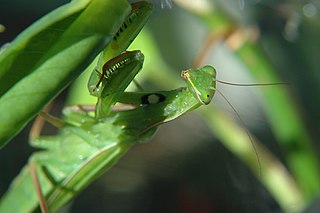
The genus Mantis is in the family Mantidae, of the mantis order Mantodea.

Ameles spallanzania, common name European dwarf mantis, is a species of praying mantis.

Brunneria is a genus of praying mantises in family Mantidae. They are often called stick mantis for their slender shape and the species of the genus are native to the Americas.

Blepharopsis mendica is a species of praying mantis found in North Africa, parts of the Mediterranean, Middle East and southern Asia, and on the Canary Islands, and the sole member of the genus Blepharopsis. Egyptian flower mantis, thistle mantis, and Arab mantis are among its common names.

Zoolea is a South American genus of praying mantises.

Rhombodera is a genus of praying mantises native to Asia and possessing common names such as shield mantis, hood mantis, and leaf mantis because of their extended, leaf-like thoraxes.

Chaeteessa is a genus of mantis. It is the only extant member of the family Chaeteessidae, the most primitive lineage of living mantises.It contains six species found in South America:
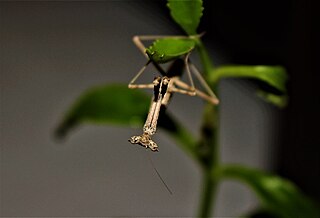
Oxyothespis is a genus of praying mantis in the family Toxoderidae. Members of this genus have been called grass mantises.

Tarachodidae is a now obsolete family in the order Mantodea, of genera found in Africa and Asia.
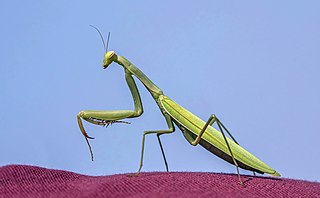
Mantises are an order (Mantodea) of insects that contains over 2,400 species in about 460 genera in 33 families. The largest family is the Mantidae ("mantids"). Mantises are distributed worldwide in temperate and tropical habitats. They have triangular heads with bulging eyes supported on flexible necks. Their elongated bodies may or may not have wings, but all Mantodea have forelegs that are greatly enlarged and adapted for catching and gripping prey; their upright posture, while remaining stationary with forearms folded, has led to the common name praying mantis.
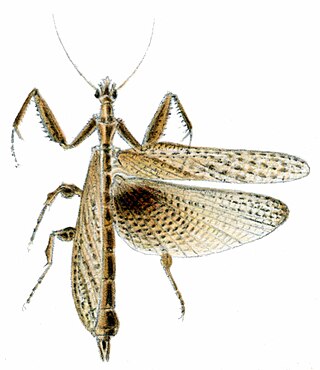
Stenophylla is a genus of praying mantis in the subfamily Stenophyllinae, which is now placed in the family Acanthopidae. It the sole genus of the tribe Stenophyllini.

Helvia is a genus of praying mantises in the family Hymenopodidae found in Southeast Asia. It is monotypic, being represented by the single species, Helvia cardinalis.
Iris orientalis is a species of praying mantis found in Asia.
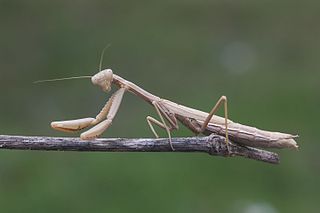
Iris polystictica is a species of praying mantis found in Central Asia, Caucasus, southeastern Ukraine, southern Siberia, China, and Mongolia. It is the only species of the mantis genus Iris that is found in Russia.


















